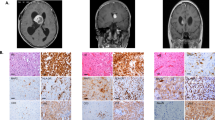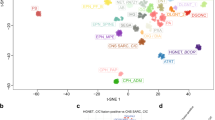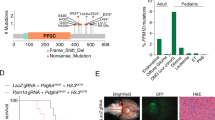Abstract
Diffuse intrinsic pontine gliomas (DIPGs) are highly infiltrative malignant glial neoplasms of the ventral pons that, due to their location within the brain, are unsuitable for surgical resection and consequently have a universally dismal clinical outcome. The median survival time is 9–12 months, with neither chemotherapeutic nor targeted agents showing substantial survival benefit in clinical trials in children with these tumors1. We report the identification of recurrent activating mutations in the ACVR1 gene, which encodes a type I activin receptor serine/threonine kinase, in 21% of DIPG samples. Strikingly, these somatic mutations (encoding p.Arg206His, p.Arg258Gly, p.Gly328Glu, p.Gly328Val, p.Gly328Trp and p.Gly356Asp substitutions) have not been reported previously in cancer but are identical to mutations found in the germ line of individuals with the congenital childhood developmental disorder fibrodysplasia ossificans progressiva (FOP)2 and have been shown to constitutively activate the BMP–TGF-β signaling pathway. These mutations represent new targets for therapeutic intervention in this otherwise incurable disease.
This is a preview of subscription content, access via your institution
Access options
Subscribe to this journal
Receive 12 print issues and online access
$209.00 per year
only $17.42 per issue
Buy this article
- Purchase on Springer Link
- Instant access to full article PDF
Prices may be subject to local taxes which are calculated during checkout



Similar content being viewed by others
References
Jones, C., Perryman, L. & Hargrave, D. Paediatric and adult malignant glioma: close relatives or distant cousins? Nat. Rev. Clin. Oncol. 9, 400–413 (2012).
Katagiri, T. Recent topics in fibrodysplasia ossificans progressiva. J. Oral Biosciences 54, 119–123 (2012).
Wu, G. et al. Somatic histone H3 alterations in pediatric diffuse intrinsic pontine gliomas and non-brainstem glioblastomas. Nat. Genet. 44, 251–253 (2012).
Lewis, P.W. et al. Inhibition of PRC2 activity by a gain-of-function H3 H3 mutation found in pediatric glioblastoma. Science 340, 857–861 (2013).
Roujeau, T. et al. Stereotactic biopsy of diffuse pontine lesions in children. J. Neurosurg. 107, 1–4 (2007).
Schwartzentruber, J. et al. Driver mutations in histone H3.3 and chromatin remodelling genes in paediatric glioblastoma. Nature 482, 226–231 (2012).
Puget, S. et al. Mesenchymal transition and PDGFRA amplification/mutation are key distinct oncogenic events in pediatric diffuse intrinsic pontine gliomas. PLoS ONE 7, e30313 (2012).
Paugh, B.S. et al. Genome-wide analyses identify recurrent amplifications of receptor tyrosine kinases and cell-cycle regulatory genes in diffuse intrinsic pontine glioma. J. Clin. Oncol. 29, 3999–4006 (2011).
Forbes, S.A. et al. COSMIC: mining complete cancer genomes in the Catalogue of Somatic Mutations in Cancer. Nucleic Acids Res. 39, D945–D950 (2011).
Shore, E.M. & Kaplan, F.S. Inherited human diseases of heterotopic bone formation. Nat. Rev. Rheumatol. 6, 518–527 (2010).
Shore, E.M. et al. A recurrent mutation in the BMP type I receptor ACVR1 causes inherited and sporadic fibrodysplasia ossificans progressiva. Nat. Genet. 38, 525–527 (2006).
Bocciardi, R., Bordo, D., Di Duca, M., Di Rocco, M. & Ravazzolo, R. Mutational analysis of the ACVR1 gene in Italian patients affected with fibrodysplasia ossificans progressiva: confirmations and advancements. Eur. J. Hum. Genet. 17, 311–318 (2009).
Petrie, K.A. et al. Novel mutations in ACVR1 result in atypical features in two fibrodysplasia ossificans progressiva patients. PLoS ONE 4, e5005 (2009).
Fukuda, T. et al. A unique mutation of ALK2, G356D, found in a patient with fibrodysplasia ossificans progressiva is a moderately activated BMP type I receptor. Biochem. Biophys. Res. Commun. 377, 905–909 (2008).
Kaplan, F.S. et al. Classic and atypical fibrodysplasia ossificans progressiva (FOP) phenotypes are caused by mutations in the bone morphogenetic protein (BMP) type I receptor ACVR1. Hum. Mutat. 30, 379–390 (2009).
Chaikuad, A. et al. Structure of the bone morphogenetic protein receptor ALK2 and implications for fibrodysplasia ossificans progressiva. J. Biol. Chem. 287, 36990–36998 (2012).
Yu, P.B. et al. BMP type I receptor inhibition reduces heterotopic ossification. Nat. Med. 14, 1363–1369 (2008).
Tumolo, M., Moscatelli, A. & Silvestri, G. Anaesthetic management of a child with fibrodysplasia ossificans progressiva. Br. J. Anaesth. 97, 701–703 (2006).
Kan, L. et al. CNS demyelination in fibrodysplasia ossificans progressiva. J. Neurol. 259, 2644–2655 (2012).
Yu, P.B. et al. Dorsomorphin inhibits BMP signals required for embryogenesis and iron metabolism. Nat. Chem. Biol. 4, 33–41 (2008).
Acknowledgements
This study was funded by the Cancer Research UK Genomics Initiative (A14078) and makes use of data generated by the St. Jude Children's Research Hospital–Washington University Pediatric Cancer Genome Project. We are grateful to the DIPG Preclinical Consortium funded by The Cure Starts Now and the Lyla Nsouli Foundation for RNA-seq data. This work is supported by the Stavros Niarchos Foundation, Abbie's Army, the Lyla Nsouli Foundation, the Royal Marsden Hospital Children's Department Fund and Fondo Alicia Pueyo. M.M. gratefully acknowledges funding by the National Institutes of Neurological Disease and Stroke (NINDS; grant K08NS070926), Alex's Lemonade Stand Foundation, the McKenna Claire Foundation and the Dylan Jewett, Elizabeth Stein, Connor Johnson and Zoey Ganesh Memorial Funds. C.P. acknowledges funding from the Agence National de la Recherche. N.T., C.P. and J.G. acknowledge funding from the charity l'Etoile de Martin, and N.E.-W. acknowledges support from Enfants et Santé. A.M.C. acknowledges funding from the Fundación Científica de la Asociación Española Contra el Cáncer. W.J.I. acknowledges funding from the Children's Health Foundation Queensland and the Brainchild Foundation. The Structural Genomics Consortium is a registered charity (1097737) that receives funds from AbbVie, Boehringer Ingelheim, the Canada Foundation for Innovation, the Canadian Institutes for Health Research, Genome Canada, GlaxoSmithKline, Janssen, Lilly Canada, the Novartis Research Foundation, the Ontario Ministry of Economic Development and Innovation, Pfizer, Takeda and the Wellcome Trust (092809/Z/10/Z). K.R.T., A.M., M.V., D. Carvalho, D.H. and C.J. acknowledge National Health Service (NHS) funding to the National Institute of Health Research Biomedical Research Centres.
Author information
Authors and Affiliations
Contributions
C.J., J.G., D.H. and S.Y. designed the study. C.J. wrote the manuscript. K.R.T., A.M. and C.J. designed and reviewed experiments, and designed and reviewed statistical and bioinformatic analyses. K.R.T. performed experiments. A.M. performed bioinformatic analyses. N.T., D. Castel, M.V. and D. Carvalho performed sample preparation and experiments. Y.S.B., O.M., C.P., C.S.G. and S.Y. performed and reviewed bioinformatic analyses. A.M.C., C.d.T., O.C., J.M., N.E.-W., W.J.I., M.M., A.N.B., S.P. and J.G. provided and prepared samples and experimental materials. All authors reviewed the manuscript during its preparation.
Corresponding authors
Ethics declarations
Competing interests
The authors declare no competing financial interests.
Integrated supplementary information
Supplementary Figure 1 Somatic mutations in TP53, PPM1D and ATM in DIPG.
Cartoon showing recurrent and non-overlapping missense and frameshift mutations in TP53 (11/26, 42%), PPM1D (6/26, 23%) and ATM (1/26, 4%), overlaid with functional protein domains and exon boundaries. TAD, p53 transactivation motif; DNA binding, p53 DNA-binding domain; PP2C, protein phosphatase 2C domain; PP2Cc, serine/threonine phosphatase, family 2C, catalytic domain; TAN, telomere length maintenance and DNA damage repair domain; FAT, FRAP, ATM and TRRAP associated domain; PI3Kc, phosphoinositide 3-kinase class I catalytic domain.
Supplementary Figure 2 Pathway-level recurrence of somatic alterations involved in DNA damage response.
Cartoon representing the frequency of distinct non-overlapping hits in intracellular components of ATM/p53-mediated DNA damage and stress response signaling. Bars are colored according to the frequency of alterations in the present cohort: red, gain of function; blue, loss of function. In total, 18/26 (69%) cases harbored an alteration at some point in the pathway that would be predicted to be activating.
Supplementary Figure 3 Somatic mutations in genes involved in PI3K/MAPK signaling in DIPG.
Cartoon showing non-overlapping missense, nonsense truncating mutations and deletions in PIK3CA (6/26, 23%), PIK3R1 (3/26, 12%), PTEN (1/26, 4%) and NF1 (1/26, 4%), overlaid with functional protein domains and exon boundaries. There were additional novel somatic mutations of unknown significance identified in IGF2R. Gray bars, deletions. p85B, p85-binding domain; RBD, Ras-binding domain; C2 PI3K 1a, C2 domain present in class 1α PI3 kinases; PI3Ka, PI3K class I accessory domain; PI3Kc, PI3K class I catalytic domain; SH, Src homology domain; RhoGAP, GTPase activator protein for Rho-like GTPases domain; COG4942, membrane-bound metallopeptidase domain; PTPc, protein tyrosine phosphatase, catalytic domain; PTEN_C2, PTEN C-terminal 2 domain; RasGAP, Ras GTPase–activating protein domain; SEC14, Sec14p-like lipid-binding domain; CIMR, cation-independent mannose-6-phosphate receptor repeat; FN2, fibronectin type II domain.
Supplementary Figure 4 Pathway-level recurrence of somatic alterations involved in RTK-PI3K-MAPK signaling.
Cartoon representing the frequency of distinct non-overlapping hits in intracellular components of the PI3K-MAPK signaling pathway, as well as amplifications of receptor tyrosine kinases, in DIPG. Bars are colored according to the frequency of alterations in the present cohort: red, gain of function; blue, loss of function. IGF2R binds IGF2 ligand preventing signaling through IGF1R-PI3K and is found to have somatic missense K162R and D1830E mutations. It total, 12/26 (46%) cases harboued alteration at some point in the pathway that would be predicted to be activating.
Supplementary Figure 5 Sanger sequencing validation of ACVR1 (ALK2) mutations in an extended cohort of DIPG.
Sequence traces of heterozygous mutations in the activin A type I receptor (ACVR1 (ALK2)) observed in a series of 50 DIPGs, including (a) c.617G>A, R206H; (b) c.983G>A, p.G328E; (c) c.983G>T, p.G328V; and (d) c.982G>T, p.G328W. All are reported to be constitutively activating of the BMP–TGF-β signaling pathway in models of fibrodysplasia ossificans progressiva.
Supplementary Figure 6 Allele-specific expression of ACVR1 (ALK2) mutation.
(a) Pileup of sequence reads from RNA-seq data of SU-DIPG-IV cells, showing expression of both the wild-type and mutant alleles at position chr. 2: 158,330,762, with 49/83 reads harboring the C>A (c.983G>T) mutation (red) corresponding to ACVR1 (ALK2) p.G328V. (b) Sanger sequencing of an ACVR1 (ALK2) exon 8 RT-PCR product from DIPG patient sample NCHP_DIPG011, showing heterozygous expression of the mutant p.G328E allele (c.983G>A), forward and reverse.
Supplementary Figure 7 Basal levels of phosphorylated SMAD1/5/8 in DIPG cells.
Protein blot analysis of phosphorylated SMAD1/5/8 (lower band) in SU-DIPG-IV (DIPG, ACVR1 (ALK2) G328V, HIST1H3B K27M), HSJD-DIPG007 (DIPG, ACVR1 (ALK2) R206H, H3F3A K27M), SU-DIPG-VI (DIPG, ACVR1 (ALK2) wild type, H3F3A K27M), CHRU-TC68 (DIPG, ACVR1 (ALK2) wild type, H3F3A K27M) and QCTB-R059 (thalamic paediatric GBM, ACVR1 (ALK2) wild type, H3F3A K27M). α-tubulin is included as a loading control.
Supplementary information
Supplementary Text and Figures
Supplementary Figures 1–7 and Supplementary Tables 2–4 (PDF 6331 kb)
Supplementary Table 1
Full list of somatic coding variants in 26 cases of DIPG. (XLSX 321 kb)
Rights and permissions
About this article
Cite this article
Taylor, K., Mackay, A., Truffaux, N. et al. Recurrent activating ACVR1 mutations in diffuse intrinsic pontine glioma. Nat Genet 46, 457–461 (2014). https://doi.org/10.1038/ng.2925
Received:
Accepted:
Published:
Issue Date:
DOI: https://doi.org/10.1038/ng.2925
This article is cited by
-
Clinicohistoradiological and surgical outcome in diffuse midline glioma
Child's Nervous System (2023)
-
Glioma synapses recruit mechanisms of adaptive plasticity
Nature (2023)
-
Convergent evolution and multi-wave clonal invasion in H3 K27-altered diffuse midline gliomas treated with a PDGFR inhibitor
Acta Neuropathologica Communications (2022)
-
The H3K27M mutation alters stem cell growth, epigenetic regulation, and differentiation potential
BMC Biology (2022)
-
Context-dependent tumor-suppressive BMP signaling in diffuse intrinsic pontine glioma regulates stemness through epigenetic regulation of CXXC5
Nature Cancer (2022)



